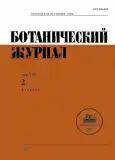MONITORING OF VEGETATION IN PALUDIFYING SMALL LAKES IN THE LOMONOSOVSKY DISTRICT OF THE LENINGRAD REGION
- Authors: Smagin V.А.1, Boychuk М.А.2
-
Affiliations:
- Komarov Botanical Institute RAS
- Institute of Biology of Karelian Research Centre of RAS
- Issue: Vol 108, No 2 (2023)
- Pages: 127-141
- Section: COMMUNICATIONS
- URL: https://rjsvd.com/0006-8136/article/view/666084
- DOI: https://doi.org/10.31857/S0006813623020096
- EDN: https://elibrary.ru/EXKFRH
- ID: 666084
Cite item
Abstract
The results of the vegetation monitoring in two paludifying lakes in the Lomonosovsky District of the Leningrad Region are reported. The paludification is triggered by a decline in the water level provoked by forest drainage melioration in the late 20th century. The vegetation of the lakes was first studied by V.А. Smagin in 1982–83, and was re-examined in 2004, 2014 and 2020. The composition of the bryoflora in the descriptions of 2014 and 2020 was determined by М.А. Boychuk. During the period of research, the successions were noted in lakeside mires, which led to the formation of the vegetation typical of lakeside mires. The vegetation lost its original mosaic and became more or less uniform throughout the profile, hardly distinguishable from “natural” lakeside mires. Meanwhile, in a number of places, the formation of a tree layer was noted. Beavers settled along the shores of the studied lakes, with various consequences. At one lake, the settlement of beavers turned out short-term and had no consequences, at the second one it was longer and affected the direction of successions and changes in the surrounding landscape.
About the authors
V. А. Smagin
Komarov Botanical Institute RAS
Author for correspondence.
Email: smagin.mire@gmail.com
Russia, 197022, St. Petersburg,
Prof. Popov Str., 2
М. А. Boychuk
Institute of Biology of Karelian Research Centre of RAS
Author for correspondence.
Email: boychuk@krc.karelia.ru
Russia, 185910, Petrozavodsk, Pushkinskaya Str., 11
References
- Czerepanov S.K. 1995. Vascular Plants of Russia and Neighboring States. St. Petersburg. 990 p. (In Russ.).
- Ignatov M.S., Afonina O.M., Ignatova E.A. et al. 2006. Checklist of mosses of East Europe and North Asia. – Arctoa. 15: 1–130.
- Hassel K., Kyrkjeeide M.O., Yousefi N., Prestø T., Stenøien H.K., Shaw J.A., Flatberg A.A. 2018. Sphagnum divinum (sp. nov.) and S. medium Limpr. and their relationship to S. magellanicum Brid. – Journal of Bryology. 40 (3): 197–222.
- Nitsenko A.A. 1967. Kratkiy kurs bolotovedeniya [Mire Science Short Course]. Moscow. 148 p. (In Russ.).
- Smagin V.A. 1984. Successions during overgrowth of small lakes under the influence of anthropogenic factors. – Bot. Zhurn. 69 (6): 827–833 (In Russ.).
- Smagin V.A. 1985. Smeny rastitel’nosti pri zarastanii melkikh vodoemov pod vliyaniem antropogennogo faktora [Successions during overgrowth of shallow water bodies under the influence of anthropogenic factors]. Avtoref. dis. …kand biol nauk. Leningrad. 18 p. (In Russ.)
- Smagin V.A. 2003. About successions during the formation and development of swamps in the place of small lakes (Leningrad region). – Bot. Zhurn. 88 (1): 76–87 (In Russ.).
- Smagin V.A., Boychuk M.A. 2022. Successions during modern swamping of lakes in the Leningrad region. – Bot. Zhurn. 107 (3): 269–286 (In Russ.). https://doi.org/10.31857/S000681362203005X
Supplementary files













